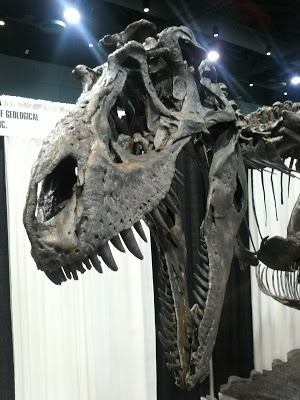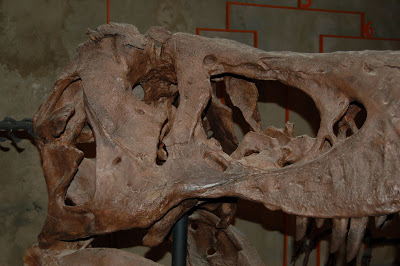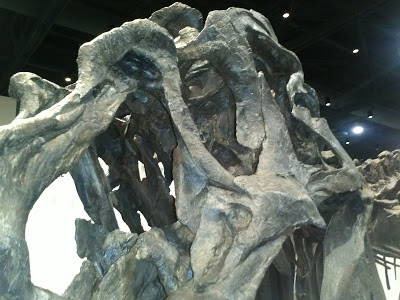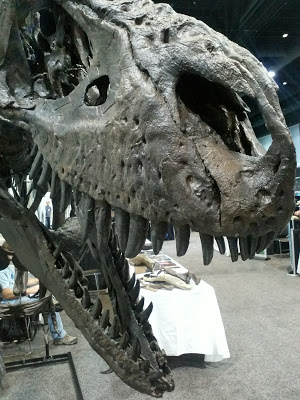(Before It's News)
At last year’s SVP there was a symposium that focussed on many aspects of the unique continent of Laramidia and this year that other long lost land on the other side of the Western Interior Seaway, Appalachia, also came under close scrutiny. One of the presentations by Steve Brusatte, of the American Museum of Natural History, and colleagues looked at the theropods of Appalachia including ornithomimids but especially tyrannosaurs which we will look at now.
Compared to the wealth of fossils that are known from Laramidia, the record of Appalachian forms is sparse. This does not mean, however, that there are no specimens available and recent work has reinterpreted those fossils that were already held in collections as well as the new fossil discoveries of recent years. The rapid evolution of phylogenetic techniques has enabled these fossils to be classified with some degree of confidence and the tyrannosauroids Appalachiosaurusmontgomeriensis and Dryptosaurus aquilunguis are extremely interesting specimens.
I recently blogged about these tyrannosaurs here and Brusatte et al are able to provide yet more detail that helps understand what was happening in Appalachia during the Late Cretaceous. The holotypes of these animals preserve both cranial and postcranial elements and the most recent phylogenetic analysis places them as intermediate forms between Asian taxa such as Guanlong and Dilong and the more derived tyrannosaurids of North America epitomised by such animals as Gorgosaurus and Daspletosaurus.
The authors suggest that these primitive forms in Appalachia remained isolated after the initial migration of basal tyrannosauroids from Asia was cut off by the Western Interior Seaway and that this particular landmass may have been a retreat from what was happening in the west during tyrannosauroid evolution. This backs up earlier work (Brusatte et al 2011) and suggests to me that there are probably many other primitive forms of dinosaur to be found and the authors point out that there is additional undiagnostic tyrannosauroid material that, although may be referable to either Appalachiosaurusor Dryptosaurus, may equally represent other taxa.
Also featured on this blog here, and numerous other blogs and websites, is the continuing fascination with the forelimbs of tyrannosaurs and one presentation, that also received some publicity at the time, was a look at the forelimb musculature of these animals by Sara Burch of Stony Brook University.
Only the forelimb of Tyrannosaurushas been studied with any intensity but Burch looked at the forelimbs of eleven tyrannosauroids as well several other outgroup taxa for comparison. The purpose was to analyse any morphological change within the group as well as trying to identify any evolutionary traits that may indicate a reduction in forelimb use.
It appears that the most rapid change in forelimb musculature took place in the early evolution of Tyrannosauridae proper although a few basal tyrannosauroids were also identified as displaying change. The scapula and humerus both display enlarged muscle attachment sites. Various other muscle attachments also highlight the significant morphological change that took place as the forelimb reduced in size. Burch then identified the numerous functional changes that occur due to the reshaping of the muscles in tandem with the resulting changes in the various tendons.
The results show that there was an obvious reduction in some musculature whilst others became more robust. What is fascinating here that, despite a superb analysis performed by the author, there appears be no clear functional evolutionary hypothesis for the forelimb. The arm in tyrannosauroids, as well as closely related taxa, was clearly capable of different functions and I suspect that the evolution of the theropod forelimb in general was fluid within taxa and did not neccesarily follow a common path. Even within tyrannosaurids proper there are obvious differences.
Incidentally, I have skimmed over this presentation since, I must confess, musculature is not a strong point for me and is something I must address. But the presentation was much more lucid and made a lot of sense at the time. It was afterward when you are trying to take it all in that it starts to confuse……
Thomas Carr continues with his awesome work on tyrannosaurs and presented his research into the ontogeny and phylogeny of the cephalic ornamentation of these animals. There is a basic cephalic pattern that all tyrannosauroids conform to that includes processes on the jugal, lacrimal, postorbital and the rugosities of the nasal.
Carr used these characters as the base codings for a phylogenetic analysis of all derived tyrannosauroids ie Bistahieversor + Tyrannosauridae. Firstly the appearance of ornamentation appears in the same order through ontogeny. Firstly the ventral jugal horn appears, followed by the lacrimal process and then the postorbital process. Both the lacrimal and postorbital horns get larger throughout growth. Carr suggests that this is important since it signifies that these bony growths probably evolved to help recognise maturity and species recognition between taxa.
Interestingly, the same ontogenetic trend is followed in the early evolution of tyrannosauroids as a whole: the early primitive form Dilong (the appearance of the corneal process of the jugal), the latter more derived Appalachiosaurus(the lacrimal process appears) and then in Bistahieversor, the appearance of the postorbital process.
There is also significant variety in the ornamentation throughout ontogeny. Most juvenile tyrannosauroids display as many three hornlet tips on the lacrimal horn but two of these are lost in adulthood. The one exception is Tyrannosaurus who loses the tip altogether at maturity.
Also of use is the fact that cephalic ornamentation can be used to diagnose taxa at the species level and there are certain characteristics, for example in Albertosaurus sarcophagus and Tyrannosaurus respectively, of the postorbital horn and the appearance of osteoderms that “cover” the lacrimal and postorbital that enable these identifications to be made.
Carr states that these species specific characteristics highlight the important of ornamentation in enabling species to recognise each other. He points to those formations that contain sympatric taxa such as Albertosaurus libratus and Daspletosaurus torosus in Laramidia and Alioramus altai and Tyrannosaurus bataar in Asia, as providing reasonable corroboration to back this hypothesis out.
Carr obviously looked at Alioramusin great detail due to his collaboration on the A. altai monograph and Alioramusobviously displays extreme ornamentation compared to other tyrannosaurids. Also of vast interest was his belief that he considers Raptorex to be a valid taxon since he was able to check out the fossils recently and characteristics in the lacrimal and horns have led him to this assertion.
Finally, I had the opportunity to talk to Thomas Carr at SVP and was very grateful that he spent some time with me chatting about all things tyrannosaur. Aside from discussing his presentation I asked him about his recent work on Daspletosaurus and was treated to a sneak preview of his upcoming monograph and it’s a big document – a VERY big document! I have been waiting for this to happen for a long long time and I was delighted that it was Thomas who was doing it. I cannot give too much away for obvious reasons but there will be, at last, details revealed about one of the new species of Daspletosaurusand maybe more…….
Following on from the aforementioned Alioramus monograph, the same team, this time led by Eugenia Gold of the Richard Gilder Graduate School, have been looking at the extreme pneumaticity of the skull of Alioramus. Because the holotype of Alioramus altai is so complete the team were able to CT scan all of the pneumatic bones and the internal recesses of the skull including those of the face, palate and lower jaw and they were looking for clues into the origins of the coelurosaurian cranial sinuses as well as the morphological changes required to accommodate the evolution of the long snout in this taxon.
Results reveal that Alioramus displays a significant amount of derived coelurosaurian/avian characteristic recesses and vindicates the belief that this suite of characters evolved early in Theropoda. This study also reveals that these very same cranial recesses suggest that cranial pneumaticity is stable in theropod evolutionary remodelling – even at the extreme snout lengthening stage of Alioramus.
The origins of tyrannosauroids remains one of the most interesting and vibrant aspects of our science. We have come to realise that the ancestors of the group probably evolved back in the Middle Jurassic and maybe even earlier. The absence of diagnostic remains has proved to be a stumbling block in our investigations but the new discoveries made in China and reappraisal of material from North America is now shedding light on this interesting aspect of the group.
Mark Loewen, of the University of Utah, and his colleagues have been looking at this in some detail and performed a phylogenetic analysis of 57 taxa and included neotheropod and coelurosaur outgroups to broaden the context of the analysis and then, in tandem with this, also re-examined the remains of the taxon Stokesosaurus clevelandi from the Cleveland-Lloyd Quarry in Central Utah.
Stokesosaurus not only retains its tyrannosauroid status and this is now reinforced by the identification of substantial new elements now assigned to the taxon. These include a premaxilla, maxilla, braincase and ilia. Bones from the craniofacial region are similar to those of Dilong, Guanlong and Proceratosaurus whilst the ilia are of particular interest and compare favourably to other recognised tyrannosauroids such as Eotyrannus and Juratyrant.
What this research helps to explain is the close relationship between Stokesosaurus and other early tyrannosauroids although we have to accept that there are still not that many specimens about that help fill the void between the Middle to Late Jurassic and the Early Cretaceous – a span of some 50 million years – so sampling remains an issue. More derived tyrannosauroids such as Dilong, Eotyrannus and Yutyrannus appear closer to Tyrannosauridae although, again, there is a yawning gap of around 40 million years between these animals and Tyrannosauridae proper. As I continue to stipulate – sampling bias is an unavoidable element that must not be discounted and Roger Benson recently mentioned to me that such sampling issues are figuring high on his current agenda.
Never the less, this research emphasises my recent thoughts on tyrannosauroid evolution and the emergence of Tyrannosauridae – namely that it is most likely that there were many different dispersal and evolutionary events throughout the Jurassic and Cretaceous involving North America, Asia and Europe and I am very confident that there are many new tyrannosauroids still to be discovered.
And finally, Zhuchengtyrannus magnus is a large tyrannosaurine recovered from Upper Cretaceous deposits in Shandong Province, China and was brought to the world early in 2011 by Dave Hone et al. In that paper it was mentioned that it was likely that there was A secondary sympatric taxon from the same formation and now Corwin Sullivan, of the IVPP in Beijing, and colleagues have now revealed more detail about this tyrannosaurid.
The quarries at Zhucheng have produced thousands of bones over the years from various dinosaurian taxa and amongst these remains were found tyrannosaurid teeth and the odd non diagnostic element. Eventually more diagnostic material came to light and Zhuchengtyrannusbecame the first named tyrannosaurid from the quarries.
Other material, however, including a maxilla and a dentary, are clearly different from the aforementioned taxon. The authors stress that this may not necessarily be a new taxon but may, indeed, be the remains of T. bataar despite the fact there are subtle morphological differences from that particular species. But as we know, and especially with Asian tyrannosaurids at the moment, morphological changes throughout ontogeny were rapid and apparently virtually continuous so these secondary remains are probably more likely to be from T. bataar.
Also of interest is that fact that the dentary from this animal displays a clear morphology which appears to be a dental abscess. The swollen area was CT scanned and appears to reveal evidence for osteomyelitic infection which has caused the deformation in the dentary. Although recognised in other dinosaurs eg hadrosaurs, this is an exceptionally rare example of this kind of infection in a theropod dinosaur. The authors speculate that that the condition would have impeded the tyrannosaurs feeding capabilities and, ultimately, led to a downturn in the animal’s wellbeing.
References
Brusatte, S.; Benson, R.; and Norell, M. (2011). The Anatomy of Dryptosaurus aquilunguis(Dinosauria: Theropoda) and a Review of Its Tyrannosauroid Affinities. American Museum Novitates, 3717, 1-53.
Brusatte, S.L.; Carr, T.D.; Norell, M.A. 2012: The osteology of Alioramus, a gracile and long-snouted tyrannosaurid (Dinosauria: Theropoda) from the Late Cretaceous of Mongolia. Bulletin of the American Museum of Natural History, (366)
Brusatte, S.L., Choiniere, J.N., Benson, R.B., Carr, T.D. & Norell, M.A. 2012. Theropod dinosaurs from the Late Cretaceous of Eastern North America: Anatomy, systematics, biogeography and new information from historic specimens. Journal of Vertebrate Paleontology, SVP Program and Abstracts Book, 2012, pp70.
Burch, S.A. 2012. Evolution of the forelimb musculature in Tyrannosauroidea (Dinosauria: Theropoda). Journal of Vertebrate Paleontology, SVP Program and Abstracts Book, 2012, pp70.
Carr, T.D. 2012. Ontogeny and phylogeny of cephalic ornamentation in Tyrannosauroidea (Dinosauria: Coelurosauria). Journal of Vertebrate Paleontology, SVP Program and Abstracts Book, 2012, pp75.
Gold, E., Brusatte, S.L. & Norell, M.A. 2012. Pneumaticity patterns in the skull of Alioramus altai, a long snouted tyrannosaurid (Dinosauria: Theropoda), from the Late Cretaceous of Mongolia. Journal of Vertebrate Paleontology, SVP Program and Abstracts Book, 2012, pp102.
Hone, D.W., Wang, K.Z., Sullivan, C., Zhao, X., Chen, S., Li, D., Ji, S., Ji, Q. & Xu, X. 2011. A new large tyrannosaurine theropod from the Upper Cretaceous of China. Cretaceous Research 32 (4): 495 – 503.
Loewen, M.A., Sertich, J.J. & Irmis, R.B. 2012. The early evolution of tyrannosauroid dinosaurs: new anatomical, phylogenetic and biogeographic evidence. Journal of Vertebrate Paleontology, SVP Program and Abstracts Book, 2012, pp129.
Sullivan, C., Hone, D.W., Rothschild, B.M. & Wang, K.Z. 2012. Tyrannosaurid dinosaurs from the Upper Cretaceous Wangshi Group of Zhucheng, Shandong Province, China: coexisting giant carnivores and a tyrant with a toothache. Journal of Vertebrate Paleontology, SVP Program and Abstracts Book, 2012, pp181 – 182.
.
Source:









